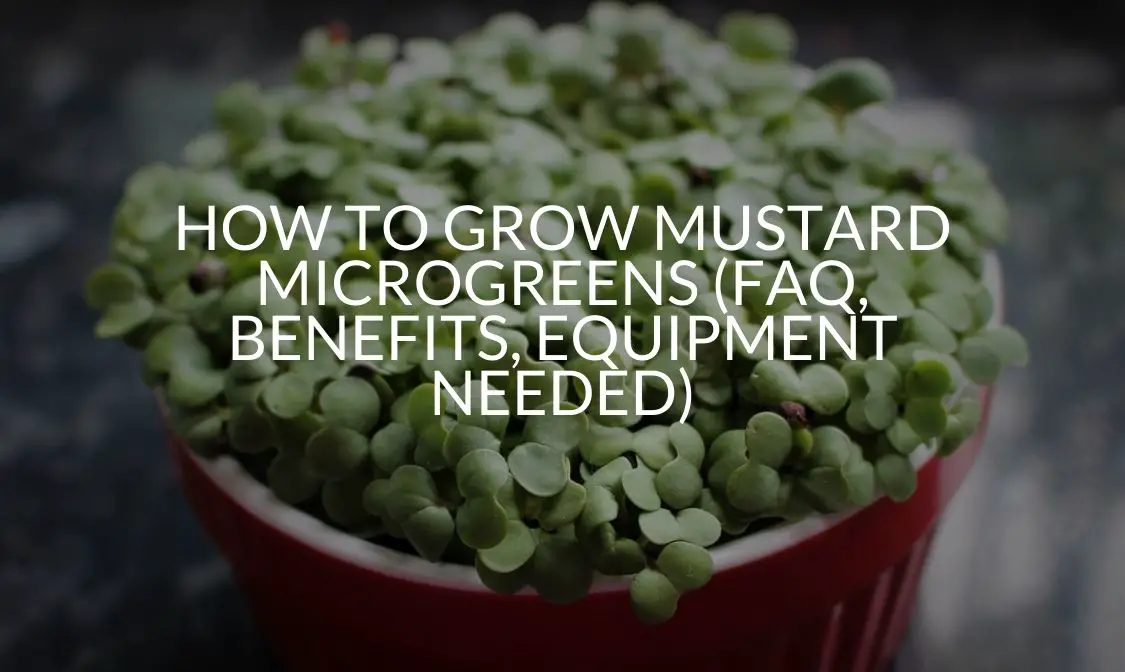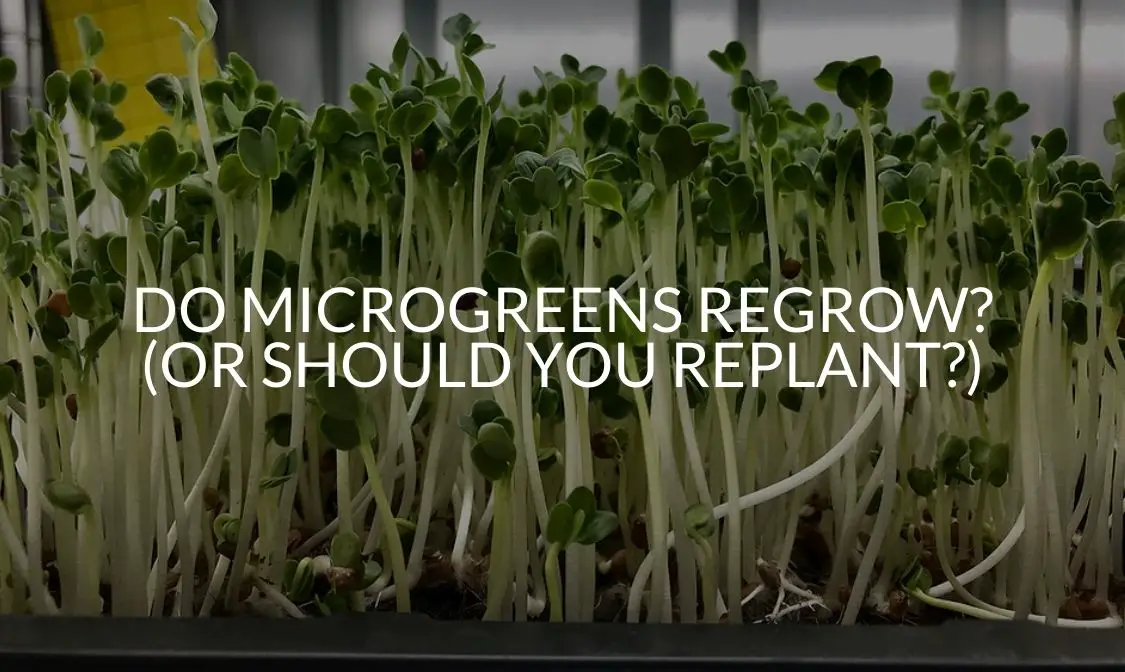Microgreens is a name that is now common in restaurant menus today.
So, what are Microgreens?
They are immature plants harvested in less than one month of germination and measure up to 2 inches.
Microgreens date back to the 1980s where chefs in San Francisco first used them. The first Microgreens ever to be produced were arugula, kales, cilantro, and beets.
Today, over 25 different types of Microgreens are grown worldwide. Cabbage Microgreens are delicious and packed with nutrients. You don’t need to have a garden or break a bank to grow cabbage Microgreens.
Today we’ll look at the step-by-step process of growing cabbage Microgreens at home.
Equipment Needed to Grow Cabbage Microgreens
You can grow cabbage Microgreens for home use or commercial purposes. Either way, you need to have the right equipment. You can purchase the equipment locally or make use of what you have at home.
Below are some of the equipment you need to grow cabbage Microgreens:
- Trays or pots – you can re-use food trays or purchase some at your local store.
- Soil sifter – You can make your own using a wire mesh and pieces of wood or get one from your local store.
- Wood Shavings – You can get the regular wood shavings for animal beddings or specialized ones for growing microgreens, as will be discussed later in this article/
- Watering spray – There are two types, which will discuss later in the article.
- Grow light- You can get a fluorescent light from a hardware store near you.
- Grow stand or shelf- to place the growing trays.
- Paper Towels – you can purchase these at your local supermarket. We’ll discuss them later.
- Cabbage microgreen seeds
- Plant markers
- Soil – You can get soil from your garden if you have one or buy particular fortified soil. We’ll discuss this later.
How to Grow Cabbage Microgreens on Soil?
You can use soil from your garden, or if you don’t have one, you can buy specific soil from your local store.
Below are the steps involved in growing cabbage Microgreens from soil:
Step 1- Prepare the Soil
Cabbage Microgreens do not require a specific type of soil because most nutrients the plants require come along with the seeds. Soil from the garden often contains debris from weeds or stones.
Prepare the soil by sifting it using a sifter to remove debris or rock which may interfere with germination.
Sifting the soil also makes it light and delicate and speeds up germination.
Step 2 – Fill the Trays with Soil
As we saw earlier, you require shallow trays to put the soil.
You need to have two trays, one with holes at the bottom and the other with no gaps.
Fill the tray (with holes) with the already sifted soil to the top.
Step 3 – Water the Soil
Cabbage Microgreens require a moist environment to germinate. You can water the soil by using either a hand spray or a hand pump. Spray enough water for the microgreen seeds to germinate.
Step 4 – Distribute the Seeds on the Soil
When you’re done preparing the soil, it’s now time to start with your Microgreens.
Using your hand is preferred so that you can distribute the seeds evenly and densely on the soil.
Gently press the seeds into the soil using your hand. Don’t push them too deep; press them slightly below the soil. You can put a thin layer of soil to cover them, but it’s optional.
Step 5 – Water the Seeds Again
Once you’re done distributing the seeds, water the soil once more using a hand spray or a hand pump. Spray enough water to the ground to germinate the seeds and prevent them from becoming soggy.
Step 6 – Cover the Tray
Use a dark tray to cover the microgreen seeds to create a dark environment.
The purpose of this step is to disguise the darkness underground and stimulate the germination of the seeds.
The seeds should remain covered for at least two days before you can check on them again.
Step 7 – Check on The Microgreens
Once you’ve covered your cabbage Microgreen seeds, check on them after two days. Check whether the seeds have started germinating. In this step, water the seeds and cover them again.
This time apply some pressure on the cover to speed up the germination of seeds. Keep watering the seeds every 12 hours. The seeds should remain in the dark for 3 to 5 days until all have germinated.
Step 8 – Put the Microgreens on the Light
When all the seeds have germinated, it’s time to put them under light for photosynthesis to begin. You can either put them under natural light or under a grow light.
You may prefer using a grow light because putting your cabbage Microgreens under direct sunlight may damage them. Put them under the grow light continually until they are ready for harvesting. This process will take 7 to 10 days.
Step 9 – Harvesting
You know that your cabbage Microgreens are ready for harvesting when they produce their third true leaf. Keeping them for too long may alter their taste too bitter, and so you should harvest them as soon as the third leaf shoots.
Use a pair of scissors to cut stems slightly above the soil or pull the roots away from the ground.
How to Grow Cabbage Microgreens On a Grow Mat?
A grow mat is another alternative to soil. There are different types of growing mats in the market, such as hemp, cocoa, bitrate, and synthetic rug.
Below is a step-by-step guide on how to grow cabbage microgreens on a mat:
Step 1 – Prepare the Mat
Prepare the mat by cutting it into your desired shape or size. Cut it to fit the container or tray you’re using.
Step 2 – Soak the Mat
Soak the mat by pouring water directly onto the tray containing the growing mat or directly spraying using a hand spray or pump. Soak the mat with just enough water to germinate the microgreen seeds.
Step 3 – Sowing the Seeds
Use your hands to distribute cabbage microgreen seeds onto the growing mat. Make sure that you spread the seeds densely and evenly for good results.
Step 4 – Water the Seeds
Use a hand spray to water the seeds one more time to stick on the growing mat.
Step 5 – Cover the Seeds
Cover the seeds with a dark tray to disguise the seeds as underground and put them in the dark for two days.
Step 6 – Check on Them
Check on the seeds on the third day to water them and monitor the progress. By now, you’ll notice that some of the seeds have started germinating. Once you water the seeds, cover them once more and apply pressure on the cover to speed up the germination process.
In this step, continue watering the seeds every twelve hours until all of them germinate.
Step 7 – Put the Seeds Under the Light
When all the seeds have germinated, put them under either a grow light or under natural light.
A grow light is preferred in hot weather conditions, and also, it distributes the light evenly and promotes upright growth of cabbage microgreens. The seeds should continue growing under the light until they are ready for harvest.
Step 8 -Harvesting
Once your microgreens are ready, stop watering them 12 hours before harvesting to drain excess water from them. You can harvest them by pulling the roots away from the growing mat or using a pair of scissors to cut the stem slightly above the growing mat.
How to Grow Cabbage Microgreens on Wood Shavings?
Using wood shavings is an affordable way of growing cabbage microgreens without using soil. This medium is locally available from your nearest feed store, and you can purchase wood shavings for animal bedding, or one custom made for growing microgreens.
Below is a detailed guide on how to grow cabbage microgreens using wood shavings:
Step 1 – Prepare the Wood Shavings
Prepare wood shavings by soaking them in water before you can use them. Fill the growing tray with the soaked wood shavings.
Step 2 – Distribute the Seeds
Use your hands to distribute the cabbage microgreen seeds evenly. For better results, spread the seeds generously on the growth medium. Slightly press the seeds to lodge them on the wood shavings to get enough water for germination. Apply a thin layer of wood shavings on the seeds to cover them slightly.
Step 3 – Cover the Seeds
Once you have successfully sowed your seeds, cover the growing tray to create a dark environment for the seeds to germinate.
Step 4 – Check on the Seeds
Check on the seeds on the third day to monitor the progress. By now, some will have started germinating. Water the seeds and cover them once more, applying pressure on the cover to speed up the germination process. Keep watering the seeds at intervals of 12 hours.
Step 5 – Put the Seeds Under Light
When all the seeds have germinated, transfer them to a well-lighted place. You can use either natural light or grow light. If you’re using natural light, keep monitoring the weather to avoid long periods of exposure to sunlight.
Step 6 – Harvesting
Between the 10th to 14th day, your cabbage microgreens should be ready to harvest. By then, the third real leaf should begin shooting. Harvest your microgreens by either cutting the stem slightly above the wood shavings or pulling away from the growing medium’s roots.
Related Articles
- Radish Microgreens (How To Grow, Benefits, FAQ’s And More!)
- Amaranth Microgreen Guide (How To Grow, FAQ & More!)
- Sunflower Microgreens (FAQ, Benefits, Pests & How To Grow)
- How To Grow Pea Microgreens (FAQ’s, Benefits, Pests)
- Carrot Microgreens (How To Grow, Benefits, FAQ, Pests)
How to Grow Cabbage Microgreens on A Growing Paper?
You can quickly grow cabbage microgreens using growing papers, which you can get from your local store. It would be best if you also had a punnet, which you can also get from a grocery store.
Below is a step-by-step guideline to do so:
Step 1 – Prepare the Punnet
Prepare the punnet by checking for holes at the bottom. If the punnet has no holes, make your own by using a knife or a pair of scissors. Fold a few papers at the bottom of the punnet.
Step 2 – Water the Paper
Soak the paper by spraying water on using a hand spray or pump. Spray just enough water to germinate the seeds.
Step 3 – Water the Bottom of the Punnet
In this step, you will need an extra container. Fill the box with water and place it at the bottom of the punnet.
Step 4 – Sowing the Seeds
Distribute the cabbage microgreen seeds on the already prepared punnet. Use your hands to evenly and densely distribute the seeds on the paper for better results.
Step 5 – Water the Seeds
Use a hand spray to water the seeds and lodge them on the growing paper.
Step 6 – Cover the Seeds
Use dark material to cover the seeds and leave them to germinate for at least two days.
Step 7 – Check on The Seeds
Check on the seeds on the second day and water them. Cover them again and apply pressure to promote germination. In this stage, keep watering the seeds every twelve hours to keep the medium moist.
Step 8 – Transfer the Microgreens to Light
When all the seeds have germinated, transfer them to light for the photosynthesis process to begin. You can use either a grow light or natural light. The cabbage microgreens should continue growing under the light until they are ready to harvest.
Step 9 – Harvest
Harvest your microgreens by the 14th day when the third true leaf has grown. Harvest using a pair of scissors to cut the stem slightly above the punnet or pull the roots away from the punnet.
How Can You Speed Up growth?
If you wish to harvest your microgreens sooner than the standard process should take, you could think about speeding up the germination rate. You can do this by increasing the soil temperature using heating mats placed below the growing tray.
What Are the Health Benefits of Taking Cabbage Microgreens?
Cabbage microgreens are easy to grow and have a myriad of health benefits. Let’s look at some of them in the section below:
Antioxidants
Cabbage microgreens are rich in beta carotene, which is a powerful antioxidant. Beta carotene helps to prevent oxidative stress by reducing free radicals. These microgreens help to prevent cancer, eye problems, and diabetes.
Vitamin C
Cabbage microgreens are also high in Vitamin C, which is useful for boosting the immune system. Vitamin C helps to prevent diseases such as flu, common cold, and cardiovascular diseases.
Vitamin E
Vitamin E is another powerful antioxidant found in cabbage microgreens. The vitamin also promotes healthy skin, hair, and nails.
Lowering Cholesterol Levels
Cabbage microgreens contain a high level of polyphenols and glucosinolates as compared to the mature form. These two compounds help to lower blood cholesterol.
Vitamin U
Vitamin U was famous in the 1950s for promoting ulcer healing and treating ulcer patients.
Cabbage microgreens are rich in Vitamin U, which is essential for a healthy gastrointestinal system.
Prevention Against Alzheimer’s Disease
Alzheimer’s is a degenerative disease that often leads to dementia in older people.
Cabbage microgreens have been found to prevent the disease by reducing Amyloid plaques’ levels, the abnormal proteins that cause Alzheimer’s disease.
Useful Minerals
Cabbage microgreens are rich in potassium, a beneficial mineral that maintains the body’s fluid and electrolytes balance. They also contain iron to boost blood, zinc for healthy skin, magnesium, and copper minerals.
What Pests Can Diseases Damage Microgreens and How to Stop Them?
Just like any other plant, cabbage microgreens are potential prey to pests and diseases. The good thing is that these can be controlled by using simple methods.
Let’s look at each and how we can prevent it:
Cabbage Worms
There are a variety of worms that prey on cabbage microgreens, such as loopers and cutworms.
The worms come in different colors, and they sometimes camouflage the color of microgreens, making them invisible. Loopers feed on leaves and eventually develop into yellow winged butterflies.
Cutworms feed on the stems of microgreens and hide in the soil. The worms move up and down depending on the moisture levels, and you can find them on the surface immediately after watering the plants.
You can prevent cabbage worms by placing a cardboard collar around the plants. You can also make a spray mixture using 1 cup of water,1 cup of vegetable oil, and one tablespoon of dish soap. Spray the microgreens on both sides of the leaf.
Aphids
Aphids attack microgreen leaves, leaving them vulnerable to attacks by other diseases.
You can prevent aphids by growing plants that attract ladybugs, which prey on them near your microgreens.
Growing mint plants near your microgreens will act as a barrier to repel aphids. You can also make a spray mixture using 1& half cups of water, two teaspoons of dish soap, and 1 cup of vegetable oil. Use this mixture to spray on your microgreens and keep aphids away.
Diamondback Moths
These pests are a significant threat, especially to cabbage microgreens. They are green or brown, and they feed on leaves and make holes. You can prevent these by intercropping mustard in the cabbage seeds two weeks before sowing.
Moths are territorial. Scattering eggshells on your microgreens will make the moths think that other moths have colonized the plants and keep away.
Snails and Slugs
These feed on microgreens at night or early morning, making them difficult to detect.
You can prevent these by pouring beer in a shallow bowl and placing it near the microgreens. Beer is known to kill these pests.
Salt is also a natural repellent for snails and slugs. Placing salt circles around your microgreens will prevent them from attacking the plants.
Harlequin Bugs
Red and black dots characterize Harlequin bugs at the back. These bugs attack small microgreens by sucking sap, leading to wilting and death. You can control these bugs by handpicking them or growing plants that repel them, such as peppermint, sage, or thyme adjacent to microgreens.
You can also make use of beneficial insects such as braconid wasps, which feed on these bugs.
The wasps are attracted by alyssum and daisies. You can also make a spray by mixing 1 ml of garlic juice with 1 ml of fish oil and 98 ml of water.
Apart from pests, microgreens are also prone to diseases. Let’s look at some of these and how to prevent them.
Black Rot
Black rot is a bacterial disease that attacks microgreens and causes nutritional deficiencies.
When the plants are infected, they turn yellow and die eventually. The disease could be caused by contaminated seeds or local transmission through open leaf margins.
You can prevent the disease by using black rot resistant seeds and raising the beds to facilitate excess water drainage.
Downy Mildew
This disease is caused by high humidity, and it causes light green to yellow patches on the upper leaf. As the disease progresses, the patches enlarge gradually, causing the leaf to die.
Downy mildew attack leaves at the seedlings stage. You can prevent the disease by clearing weed and controlling the humidity levels.
Club Root
As the name suggests, the disease affects the roots, causing them to swell. After infection, the roots take three weeks to swell. When the disease attacks microgreens at the seedlings stage, it causes death.
You can prevent the disease by ensuring that the seeds you’re using are not contaminated.
Ensure that you raise the soil’s PH to 7.0 and clean the equipment used to grow the microgreens.
FAQs
Cabbage Microgreens VS Cabbage Sprouts (Which is Better?)
Cabbage sprouts are newly germinated seeds that are harvested before leaves are formed. On the other hand, cabbage microgreens are harvested when the first real leaves are formed.
Cabbage microgreens add color and flavor to food, especially in salads and sandwiches. They can be eaten raw and are packed with vitamins and antioxidants. Cabbage sprouts are less nutritious than their microgreens. When you eat raw cabbage sprouts, you may be at risk of contracting E. coli, a bacterial infection.
How Much Light Do Cabbage Microgreens Need?
Microgreens require about 4 to 6 hours of exposure to light in a day. You can expose them to natural light from outside or artificial light using a grow light.
What Temperature Do Cabbage Microgreens Need?
Cabbage microgreens require a high temperature of above 75 degrees to germinate. Once germinated, the temperature should be lowered to 60 degrees and maintained at an optimum temperature of 60 to 70 degrees F.
How Long Do Cabbage Microgreens Take to Grow?
Cabbage microgreens take approximately 2 to 3 days to germinate and 7 to 14 days to grow. We could say the whole process takes around two weeks.
Do Cabbage Microgreens Regrow After Harvest?
Cabbage microgreens can regrow if they are harvested in the right way. By this we mean, cutting the stems instead of pulling the roots away from the growing medium.
If you wish to regrow cabbage microgreens, cut the stem slightly below the third real leaf while harvesting and care for them following the steps we discussed earlier.
How Should You Harvest Microgreens?
You can harvest microgreens either by cutting the stem above the growing medium using a pair of scissors or pulling the roots away from the growing medium.
How Should You Store Cabbage Microgreens?
After harvesting cabbage microgreens, you should drain excess water by pressing them against two kitchen towels. Put them in a sealable container or bag and store them in a fridge for a maximum of 7 days.
Why Are My Microgreens Falling Over?
Microgreens may over due to lack of enough water, putting too many seeds in a small space, lack of enough light, too much pressure when watering, and when they grow too tall and thin.
Cabbage Microgreen Flavor+ How to Use Them?
Cabbage microgreens are tasty and packed with nutrients. They are great when taken raw in the form of salads, sandwiches, and burgers. Because they are delicate, you should be using them in salads with light dressing and sprinkling on soups and completing meals.
How Do You Prevent Damping-off /Why Is Air Movement Important?
Damping happens due to fungus infection, which thrives well in a humid environment. You need to ensure proper air movements throughout the day to prevent damping, fungus, and pests.
You can prevent damping by cleaning equipment before use, provide enough light, and use grow trays with holes at the bottom to drain excess water.
Recap
This article proves that growing cabbage microgreens is fun, easy, affordable, and can be done by anyone. Cabbage microgreens are excellent sources of antioxidants, Vitamins, and minerals, and they make great recipes for salads and sandwiches.
With or without a garden, you can still grow cabbage on other non-soil mediums such as paper, growing mat, and wood shavings.
Growing cabbage microgreens comes with its shares of challenges, such as pests and diseases, but this article has outlined how to identify, prevent and control them.
With this kind of information, you can quickly grow cabbage microgreens and later other microgreens of your choice. Remember, there are over 25 varieties of microgreens grown today!






